The Rebirth of SailGP’s US Squad
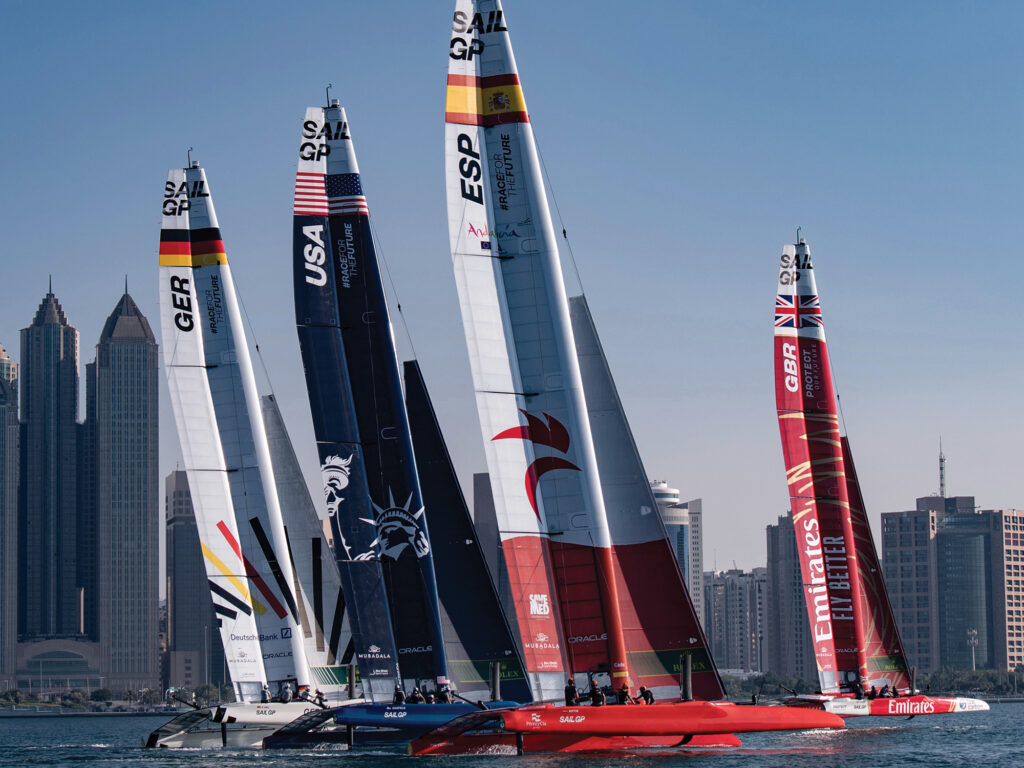 Germany SailGP Team helmed by Erik Heil, USA SailGP Team helmed by Taylor Canfield, Spain SailGP Team helmed by Diego Botin sail behind the Emirates Great Britain SailGP Team helmed by Giles Scott during a practice session ahead of the Mubadala Abu Dhabi Sail Grand Prix.
Ricardo Pinto
Germany SailGP Team helmed by Erik Heil, USA SailGP Team helmed by Taylor Canfield, Spain SailGP Team helmed by Diego Botin sail behind the Emirates Great Britain SailGP Team helmed by Giles Scott during a practice session ahead of the Mubadala Abu Dhabi Sail Grand Prix.
Ricardo Pinto
Jimmy’s out. Taylor’s in. This is the all-American team you’ve been waiting for. Or not. Either way, this fresh new squad has plans to make you care about them and SailGP, the five-year-old professional sailing league that’s halfway through its fourth season. And when they say “care,” they mean follow, watch, click, like, react, share, come to the sidelines, and stay for the party. Real and lasting fandom is all about reach these days, and if the new honchos of the US SailGP Team deliver on their promise, they’re going to reach right through your chest cavity, grab your heart, and make you a believer.
Until late last year, the F50 catamaran with Lady Liberty on its towering blue wing was all Jimmy Spithill and Co., and while no one in their right mind would refute the GOAT-ness of the Australian helmsman and CEO, back-to-back seasons with mixed results was an opportunity to start anew. Spithill, plenty busy with the final ramp-up of the Luna Rossa Prada Pirelli America’s Cup challenge, finally cashed out, opening the door for a couple of hungry homies.
.embed-container { position: relative; padding-bottom: 56.25%; height: 0; overflow: hidden; max-width: 100%; } .embed-container iframe, .embed-container object, .embed-container embed { position: absolute; top: 0; left: 0; width: 100%; height: 100%; }Through that door sauntered the team’s new co-owner and CEO, Mike Buckley, a professional sailor and New Yorker with big-city connections, and a pit bull of a salesman with a burning desire to forge a new and more diverse era of American sailing. Buckley and his franchise skipper, Taylor Canfield, once tried to crack into the America’s Cup club with their scrappy Stars & Stripes campaign but came up short. That’s now ancient history, and Buckley persists. Opportunity knocks: the American team, a turnkey global circuit with 13 events, legit waterside hospitality in nine different countries, and $7 million in prize money by the time the season champs pop corks in San Francisco in July.
Buckley, 41, announced the team’s entry to the league in December, comparing it to an opportunity to buy the New York Yankees of sailing. The pickup—said to be well above a $40 million evaluation—is backed by a portfolio of celebrities, professional athletes, tech moguls and private investors. Ryan McKillen and his wife, Margaret, the team’s co-owners, are both keen racing sailors based in Miami and Newport, Rhode Island. They have sailed against or alongside Buckley and Canfield over the past few years, primarily in the tightknit top of the J/70 and M32 Catamaran classes.
A longtime pro sailor himself, Buckley is an unabashed professional-sports fanatic and a self-made businessman who was destined for his role leading the team from the owners’ box and making sure celebrity guests and team partners are enjoying their VIP regatta experience. And how could they not? Free-roaming the team base, hanging with the sailors, an afternoon of teetotaling, and big foiling catamarans hurtling toward each other at 50 knots is cool. Plus, SailGP does put on a proper sailing spectacle for the curious masses and the broadcast subscribers who watch in high numbers.
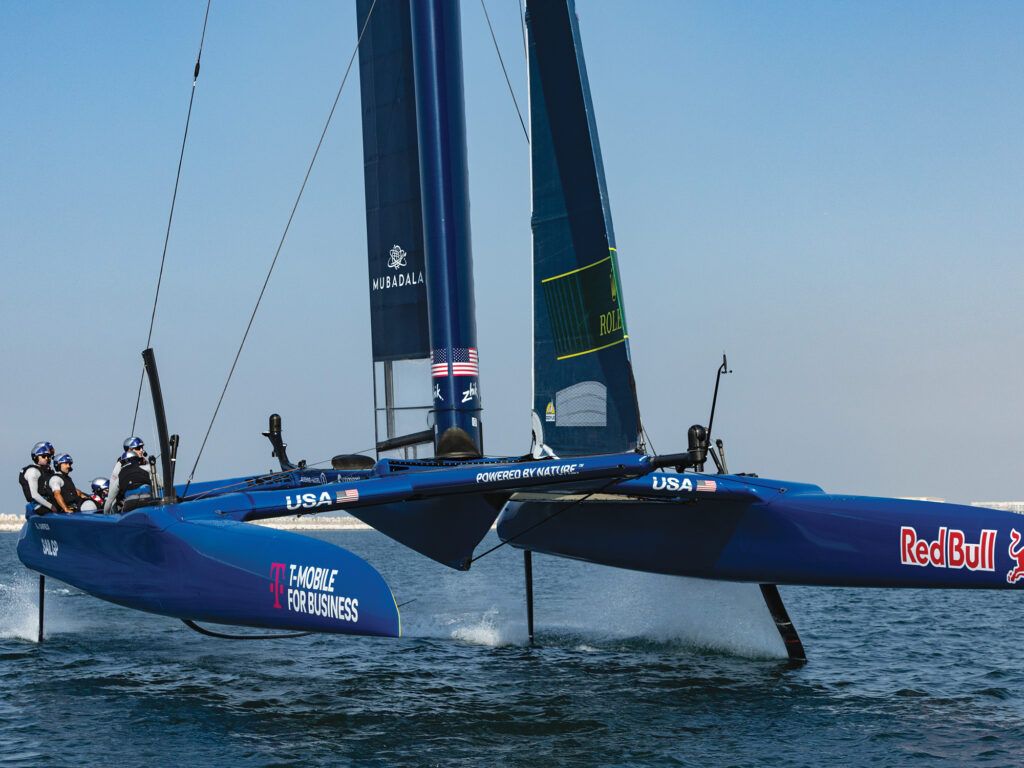 Taylor Canfield’s assessment after his team’s first event in Dubai: “When we are dialed in, it’s obvious we can fight with the best.”
Kieran Cleeves
Taylor Canfield’s assessment after his team’s first event in Dubai: “When we are dialed in, it’s obvious we can fight with the best.”
Kieran Cleeves
Buckley genuinely believes what he’s selling. “There’s great value in owning these teams, and they see the potential of enormous growth with an emerging league,” he said in December. “Over the past 20 years, sports [properties] have become one of the most sought-after asset classes out there. SailGP is now on the map to be one of those vehicles.”
The majority of his celebrities and athletes have never gone upwind on a sailboat before, but Buckley says that it doesn’t matter. What’s important to him is getting them excited and growing a fan base beyond the traditional and minuscule sailing bubble. “Athletes are looking to own things,” he says. “So this is an opportunity for them—they’re all competitors—to invest in a sports team. We were very passionate about going outside the sailing community to bring new eyeballs, new ideas, new minds and new ways of doing things to tie this to the mainstream audience.
“The pitch is quite simple,” he adds. “If you’re looking to invest in a media and entertainment platform that is also a professional sports team, we have a really cool option. It’s a professional sports team that happens to race sailboats at 50 to 60 miles an hour at events around the world. I want to deliver three things: Enterprise value to all of us; I want to change the sport off the water, to make it more accessible; and I want to win. I want to win the championship.”
During a meeting in Los Angeles earlier in the year, league founder Russel Coutts’ advice to Buckley was simple: A team that finishes at the back of the fleet will not be commercially viable.
“Fair enough,” Buckley countered. Deal inked. And in a blink, his startup sailing team hastily assembled days before its first event, in Dubai, in mid-December, with Canfield leading on the water and in the locker room. Raised in the balmy breezes of the US Virgin Islands, Canfield, 35, has long been one of American sailing’s best and most underappreciated competitors. Ashore, he’s a man of few words, keeper of a low profile, an ace tactician-for-hire, and a transient resident of Miami and Newport, the seasonal sailing capitals of the East Coast. On the water, especially at higher speeds, he’s tenacious, calculated and aggressive—all traits that have ascended him to the top of the match-racing world many times over. “Elbows out” is one of his favorite phrases. Always followed with a smirk.
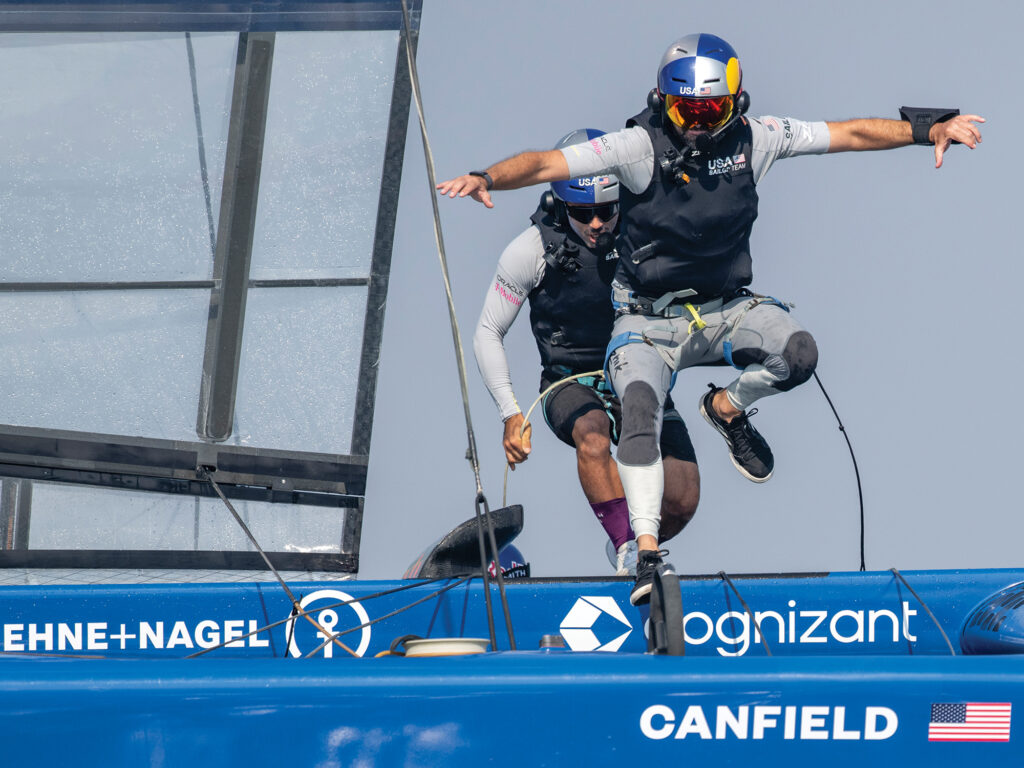 Co-owner and CEO Mike Buckley jumps into the action during a practice session in Dubai.
Ricardo Pinto
Co-owner and CEO Mike Buckley jumps into the action during a practice session in Dubai.
Ricardo Pinto
Canfield and Buckley go back a ways, and when they’re together, they yin to yang. Canfield is reserved with his words. Buckley, much less so. Both are confident and persuasive.
“On the boat, I’m a complete pain in the ass,” Canfield once told me. “I’m the most meticulous, demanding and hyperfocused person you could sail with. I don’t know if it’s a good thing or my downfall, but I try to let nothing go by.”
Positioned immediately forward of Canfield in the cockpit of the team’s F50 in Dubai on practice day was Victor Diaz de Leon, a Venezuela-born professional sailor now living in Miami. He’s also a top-shelf tactician for hire, a fast learner, and great on camera. Before arriving in the UAE, Diaz de Leon, 32, had never trimmed an F50 wing or touched any of the many buttons in the cockpits that manipulate the sail in a million different ways. Flight control (adjustment of the foils) and grinding responsibilities were put into the rotating hands of SailGP alumni Leo Takahashi, Scott Ewing, Peter Kinney, Alex Sinclair and Mac Agnese. Sara Stone, strong and well-versed in foiling boats, rounded out the team in Dubai, as its strategist and grinder.
Dubai was event No. 6 of the season, so the US team picked up where Spithill left off (third overall in the season standings), but with only three practice runs on the F50, they fumbled around the racecourse and battled at the back of the fleet. To be expected. But still, on their first day, they were in the hunt early, and were never once last across the finish line. That alone would be an accomplishment for mere mortals.
Visible improvements were noted on the second day of the regatta, but similar results followed, and there was scant air time on the broadcast. It was pretty dismal until, in the final fleet race, Canfield famously blocked out the British team at the start, forcing them out of the race completely, irking the great Sir Ben Ainslie and denying the Brits a spot in the winner-takes-all final race. The seemingly aggressive move by the rookies sent the broadcast commentators and social media into a tizzy.
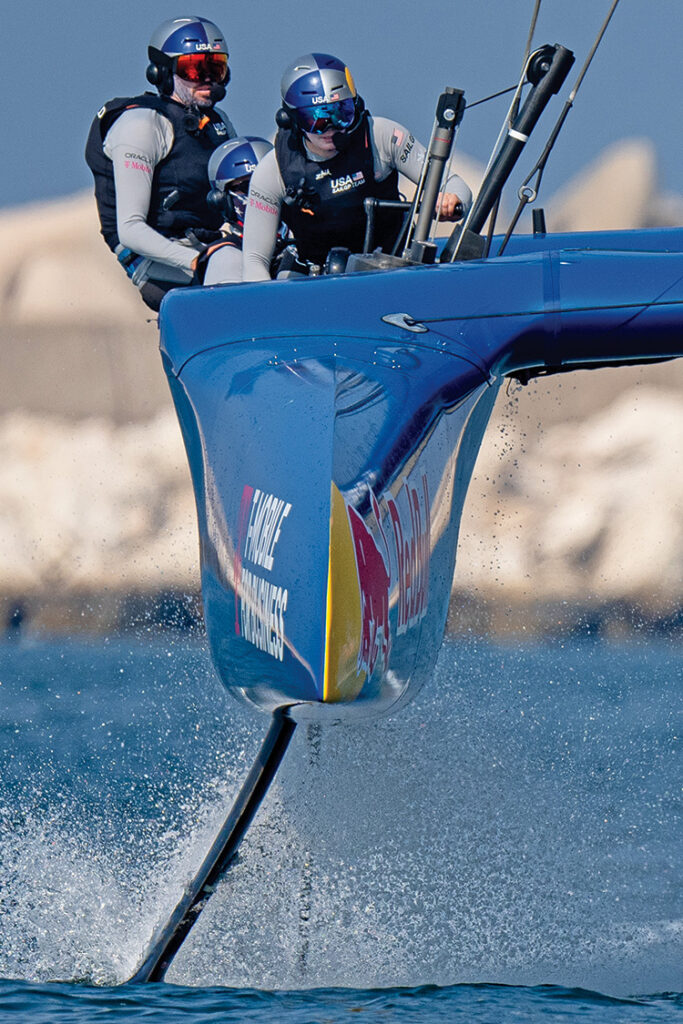 US SailGP Team skipper Taylor Canfield is experienced and confident in close-quarters catamaran racing, which benefited the team in Abu Dhabi.
Bob Martin
US SailGP Team skipper Taylor Canfield is experienced and confident in close-quarters catamaran racing, which benefited the team in Abu Dhabi.
Bob Martin
“There was no intention of shutting them out,” Canfield shared afterward. “Our goal was to start off the line and not be over early, which is extremely difficult to do in these boats. Not having used any of the starting software, it was a challenge to get it perfect. We got a lot of criticism for it, but we were less than a second behind the line, so we pushed hard.”
Elbows out, indeed, and good on Canfield. Racing is racing, and the video doesn’t lie: It was his start to win. The umpires agreed.
By all accounts, Dubai was a wonderful trial by fire for the rookies, survivors of surprises from every direction on land and on the water as they acclimated to the SailGP circus life and came to grips with a complex boat and two different wing sails.
“The first day felt as if we were really hurting on the jibes relative to the fleet,” Diaz de Leon says, “and afterward, when we reviewed the data, we could see that we were doing something completely different with our boards at the exit of the jibes. We started to match the fleet, and the second day felt much better in the maneuvers. Two days before, we couldn’t tack without having a massive crash, so it felt like we were making gains quickly.”
Diaz de Leon even called his father at the end of the first day and told him to expect them to finish last in every race, maybe by a leg or two: “I said, ‘I don’t know how I’m gonna figure this out in three days. I have my hands full, and I’m completely over my head.’ But every day we got a little bit better, we reviewed the data, and we looked at other teams; we worked together and ended up making it happen around the course.”
Four weeks later, the US team was back on the tools, this time in Abu Dhabi. Buckley’s fashion-statement “walk-in” (like the pro athletes do it) on the red carpet leading into the race village had a hint of swagger. Deep-dive debriefs with Coach Mark Ivey confirmed that with a better handle on the F50, they were capable of mixing it up with the dominant teams of New Zealand and Australia, the three-time season champion.
A light-wind forecast welcomed the American team into its wheelhouse. Canfield has spent most of his pro-sailing lifetime racing M32 catamarans, and when the wind goes soft and weird and the F50s big foils are useless, the racing is very similar to that of the M32s. “H1” is the league’s jargon for flying a hull. “H2” is full-displacement sailing. The skill is sailing the right mode at the right time and not reaching all over the course.
“From having done a lot of starts in displacement mode, similar to the M32, the kind of elbows-out leading back into the start-line mentality was what we were trying to go for,” Canfield says. “It works well for us. The goal is to not necessarily need to lead at the first mark, but to leave ourselves in a decent position to either defend or have the opportunity to push forward into the race.”
Watch enough SailGP starts, especially those in subfoiling conditions and impossibly small starting areas, it’s obvious that the final 10 seconds are crucial. It’s either front row or shot out the back, and when you’re in the back, good luck pushing forward. “These starting lines are set up so that there’s just enough room for all the boats to be side-by-side going toward Mark 1,” Canfield says. “But when it’s light and all the boats are paralleling the starting line, you can really fit only half of them on the line.”
The US team pulled off three keeper starts on the opening day and put up a ninth-place finish in the first race, but then posted a second in the next and a third in the race that followed. With a fourth and a third in similar conditions the following day—to their own surprise—they conquered the fleet-race portion of the regatta and earned the top seed in the one-race finale.
“The fact that we were able to get our heads out of the boat and be comfortable enough to start looking around the racecourse was huge,” Canfield says. “That was a big step for us, being comfortable enough in our roles on board to then start putting the racecourse together a little bit more.”
They also benefited from the keen eye of Ivey, who can communicate directly to them from the onshore coach’s box, a new addition for the season, a la Formula One with a twist, which allows each team’s coach to view real-time performance data from across the entire fleet, and to communicate observations directly to the team during the race.
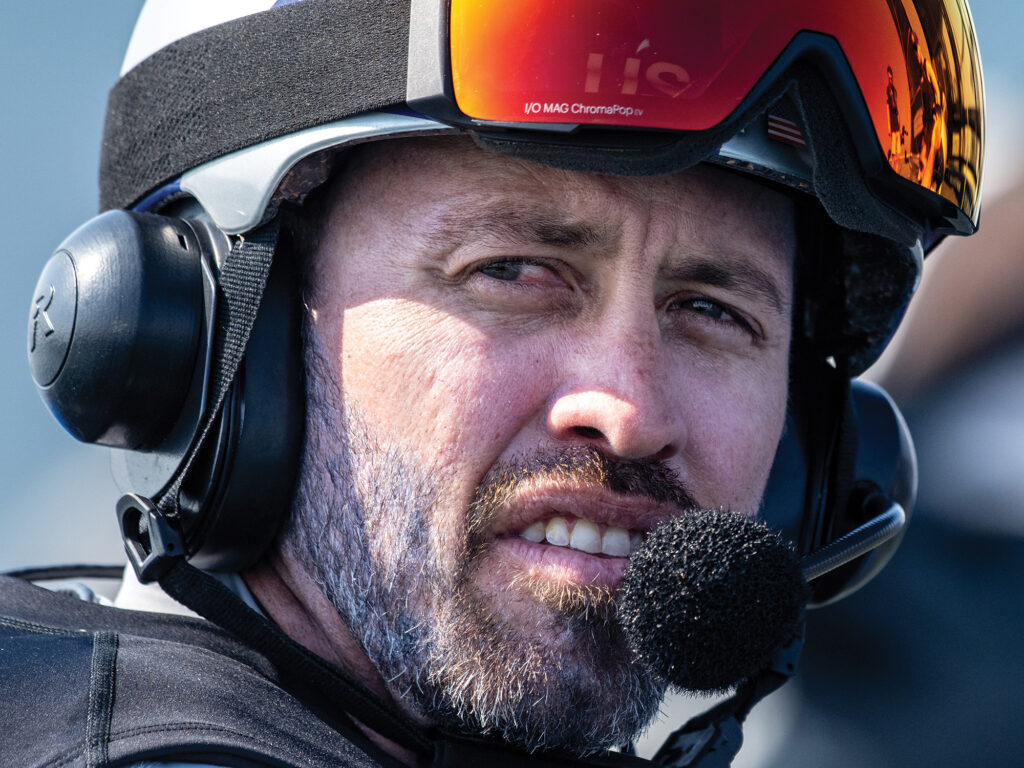 Canfield’s tactical acumen served him well in the team’s first two events.
Ricardo Pinto
Canfield’s tactical acumen served him well in the team’s first two events.
Ricardo Pinto
“Utilizing that better with Mark was a huge jump for us,” Canfield says. “He can look at all the wind on the racecourse in real time, but he can also look at data from other boats and tell us if we’re out on our target wing-camber numbers or twist numbers or whatever. They have all the metrics, and they can get us information immediately, which is huge, so we worked hard to refine the communication between us during the racing.”
It’s early days yet, but Canfield says that he could feel the essentials starting to click in Abu Dhabi. “Everything on board is a little bit more second-nature, but that’s not to say we’re ready to just push our buttons without looking at them. I think we’ve done a great job focusing on certain areas that we think we need to improve and areas that we know will take us a big step forward rather than a small step forward.”
The experience of the first events was “super overwhelming” at first, he says, with so many unknowns. “But now, after only two events, we’re starting to home in on what we think are the big things that are going to make that big jump in the results.”
Canfield’s a realist and accepts that the team’s first two events were essentially drifters. The blazing speeds, the crashes and the capsizes will come soon enough. “We’ll have our work cut out for us,” Canfield admits. “We have a lot to come when we get up on the foils.”
Fast approaching is the eighth event in Sydney, Australia, at the end of February; then Christchurch, New Zealand; Bermuda in May; Halifax in June; and then the big home event in New York City in late June.
The team’s fan base is growing, says Diaz de Leon: “I feel it. People are excited to finally have sailors who they feel close to. I can feel the support, and it’s motivating us to do well by them.” It’s all on the up.
The post The Rebirth of SailGP’s US Squad appeared first on Sailing World.
- Home
- About Us
- Write For Us / Submit Content
- Advertising And Affiliates
- Feeds And Syndication
- Contact Us
- Login
- Privacy
All Rights Reserved. Copyright , Central Coast Communications, Inc.